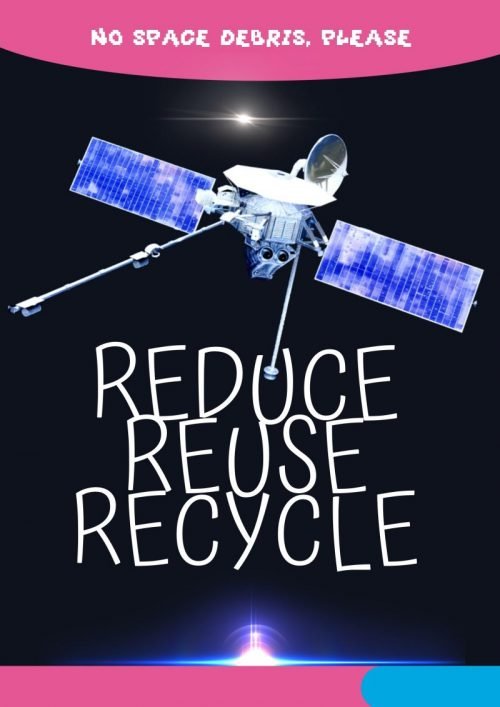Every year we launch hundreds of satellites into space. They do lots of amazing jobs and help us with things like communication, navigation, weather and climate monitoring and, of course, space research. But what happens to the spacecraft when they retire?
Obviously, we cannot just leave a no-longer-working piece of equipment in its orbit. Every “dead” object, every screw, every piece of foam and speck of paint circling around the Earth at a tremendous speed poses a danger to the operational spacecraft as well as current and future manned missions. Therefore everything we send up must be thoughtfully disposed of. How?
Depending on the size of a spacecraft and the type of orbit it follows we can choose to use one of the two disposal options:
1) to DE-ORBIT, i.e. to send a spacecraft “down” to burn in the atmosphere and/ or splashdown in the ocean
2) to RE-ORBIT, i.e. to move it “up” to a graveyard orbit
UP AND AWAY?
If a spacecraft is orbiting very high above the Earth (for example, in Geostationary orbit), it would take a lot of extra fuel to bring it down to burn in the atmosphere. The alternative is to push it even further away from the Earth and place it in a so-called “graveyard orbit” out of the way of working satellites. We would like to point out that graveyard orbits are not an ideal long-term solution. Many spacecraft disposed of this way do not reach their designated graves. But even those that do, are still up there, “out of sight, out of mind” for now, but waiting to become a potential problem, either as they begin to age and crumble or as “the grave” becomes more and more crowded.
BRING IT DOWN!
Most spacecraft we launch, we place in a so-called Low Earth Orbit (LEO), that is an orbit with an altitude up to 2000 km.
For example, Hubble Space Telescope, International Space Station and Iridium satellites are in Low Earth Orbit. This is a very attractive zone, as it requires the least amount of fuel to get to. But because it is so accessible, the number of man-made objects in the LEO grows at an alarming rate. The Inter-Agency Space Debris Coordination Committee requires that any retired spacecraft should be removed from LEO within 25 years after the end of the mission.
To dispose of a spacecraft orbiting in a lower part of LEO we can take advantage of the Earth’s atmosphere. Collisions with air particles, as few as they are at those “space” altitudes, naturally slow spacecraft down causing them (without altitude correction) to reenter the atmosphere and burn up well within the required 25 years. Small spacecraft will be completely destroyed at an altitude higher than 70 km, therefore posing no threat to airplanes (cruising altitude for most commercial airplanes is 9.5 km – 12 km) or humans on the ground.
Smaller satellites and those in higher LEO will take longer to deorbit and therefore need a little help. We can use leftover fuel or install a special device to push a satellite “down”. Examples of deorbiting mechanisms currently being used include solar sail , drag sail and external D-Orbit Decommissioning Device.
Controlled splashdown
Bigger satellites and space stations are, well, too big to burn up in the atmosphere. They will fall apart during the descent, but some parts will survive the downfall. We cannot predict where the pieces will land and therefore the uncontrolled disposal is no longer safe. In that case we can use controlled reentry, i.e. guide a spacecraft to land in the ocean away from human habitation. Luckily, water covers 71% of the Earth’s surface, so it’s not that difficult. The popular dumping ground is an area around the so-called “point Nemo”, the farthest point from land on planet Earth.
We aim for Point Nemo, but is it the right thing to do?
There is a place on Earth in the southern Pacific ocean. It is so remote, that the nearest people are the astronauts aboard the International Space Station. There is very little shipping traffic and marine life is very scarce there too. No wonder that this spot, officially called “South Pacific Ocean Uninhabited Area”, was chosen as spacecraft cemetery. Since 1971 over 260 spacecraft have found their last home in those remote waters.
While dumping man-made space objects “in the middle of nowhere” might sound like the only viable option, many scientists and lawmakers are concerned about its harmful consequences for marine life. We would recommend paper
From Outer Space to Ocean Depths: The ‘Spacecraft Cemetery’ and the Protection of the Marine Environment in Areas Beyond National Jurisdiction to those interested to explore this problem further.
More about satellites
Here are some other blog posts about satellites you might like to read:
How to talk to a far-away spacecraft: Deep Space Network
3-2-1… How and where to see a rocket take-off
Do we really need to put telescopes in Space?
Satellite navigation and and how it works
If you would like to learn more about satellites and robotic space exploration, visit our portable planetarium or send your question to our dedicated space dome team.

